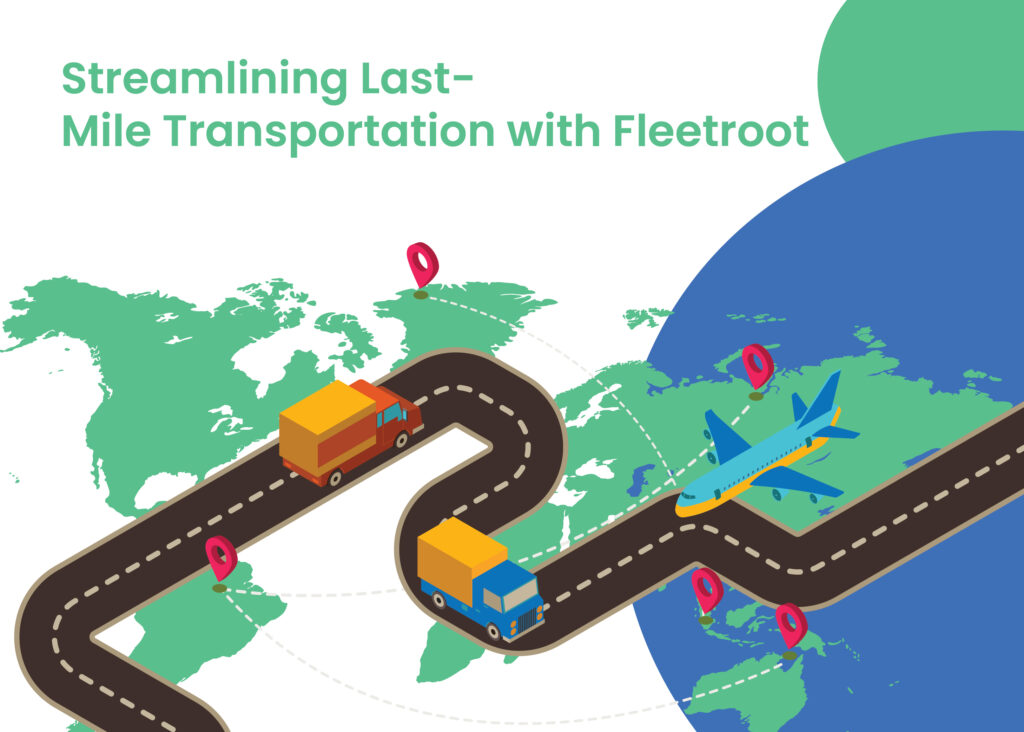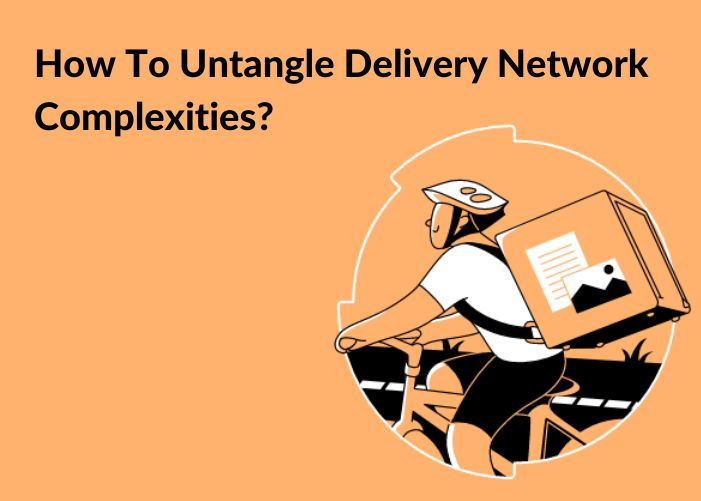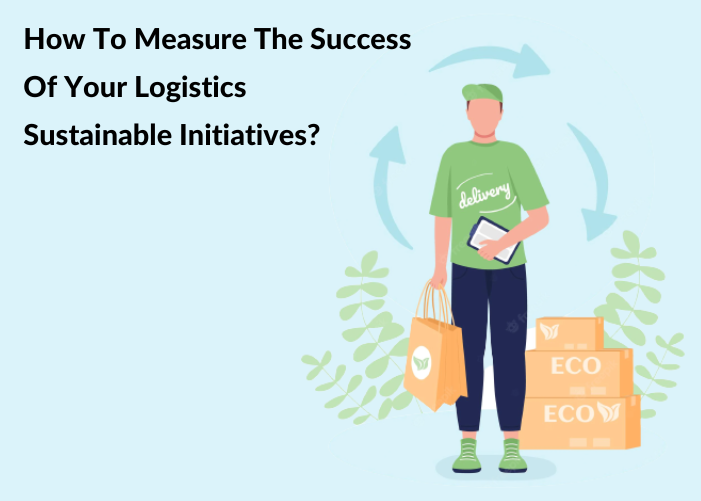In the world of logistics and supply chain management, last-mile transportation is the linchpin of success.
This crucial phase involves delivering goods from a distribution point to the final destination, whether it’s a consumer’s doorstep or a business. We recognize the pivotal role last-mile transportation plays in the overall efficiency of the supply chain. In this comprehensive guide, we delve into the intricacies of last-mile transportation and how Fleetroot’s solution can help you optimize this critical phase of the delivery process.
Table of Contents
1. Introduction
- The Significance of Last-Mile Transportation
- The Role of Fleetroot
2. Understanding Last-Mile Transportation
- Defining Last-Mile Transportation
- Components of Last- Mile Delivery
3. Why Last-Mile Transportation Matters Challenges and Importance
- The Cost Factor
4. Fleetroot’s Solution for Last-Mile Transportation
- Overview of Fleetroot’s Offering
- Key Features and Benefits
- Last-Mile Mode of Transportation
- The Average Cost of Last-Mile Delivery
- The Role of a Last-Mile Delivery Carrier
- The Future of Last-Mile Transportation
- Conclusion
1.Introduction
The Significance of Last-Mile Transportation
In the vast world of logistics and supply chain management, the last mile is where the rubber meets the road – quite literally. It’s the final stretch of the delivery journey, from the distribution center to the end customer’s location. The efficiency of Last-Mile transportation directly impacts customer satisfaction, operational costs, and overall supply chain effectiveness.
The Role of Fleetroot
We provide a robust, user-friendly platform designed to transform your Last-Mile delivery and transportation processes. Our platform offers a wide range of applications and functionality, all geared towards running an optimized, efficient Last-Mile delivery operation. With a fully integrated solution for every stage of the Last-Mile process, we aim to keep your operation running smoothly while ensuring both driver and customer satisfaction.
2.Understanding Last-Mile Transportation
Defining Last-Mile Transportation
Last-Mile transportation involves moving goods from a distribution center to the end customer’s location, encompassing intricate route planning and Real-Time tracking for efficient, timely delivery.
Components of Last-Mile Delivery
Last-Mile transportation includes order tracking, scheduling, asset management, dispatching, route planning, customer communication, and delivery confirmation. Coordination across these components is essential for a seamless delivery process.
3. Why Last-Mile Transportation Matters
Challenges and Importance
Last-Mile transportation is a critical customer touchpoint where delays or inefficiencies can harm your brand’s reputation. Challenges include congestion, traffic, and navigating complex urban environments, necessitating adaptable solutions.
The Cost Factor
Last-Mile delivery is often the costliest supply chain stage, with approximately 41% of worldwide supply chain costs attributed to it. Costs vary based on geographic density, package size, transportation mode, fuel costs, driver wages, and vehicle maintenance, with estimates ranging from $10 to $50 per package. We can help you address these challenges.
4. Fleetroot’s Solution for Last-Mile Transportation
Our solution optimizes Last-Mile transportation with features like dynamic route planning, Real-Time tracking, and order confirmation for efficient operations.
Key Features and Benefits
Dynamic Route Planning: It adapts routes in Real-Time based on factors like road conditions, weather, and customer time windows, ensuring efficient routes and cost savings.
Real-Time Notification and Tracking: Customers receive Real-Time updates on order status and location, enhancing their experience.
Dispatch and Driver Management: Orders are dispatched efficiently to drivers and vehicles, considering scheduled routes and customer locations. Drivers receive notifications through a mobile application, ensuring smooth operations.
Integration with Various Transportation Modes: Our platform accommodates a variety of transportation modes, from traditional vehicles to electric ones, bikes, and potentially future technologies like drones and automated delivery robots.
Order Confirmation: Customers are promptly notified upon successful delivery, building transparency and trust.
We offer an all-in-one platform to optimize Last-Mile transportation operations.
5. How Last-Mile Transportation Works
Route Planning and Optimization
Route planning is essential for efficient Last-Mile transportation. While traditional routes are static, dynamic route planning adapts to Real-Time data, ensuring drivers take the most efficient path.
Order Receipt
Orders are entered into a centralized digital system upon receipt, enhancing accuracy and reducing errors.
Real-Time Notification and Tracking
Customers receive Real-Time notifications about their orders, improving their experience with timely updates.
Goods Arrive at a Distribution Point
Goods arrive at a distribution center, awaiting loading onto delivery vehicles.
Dispatch
Efficient order assignment to drivers and vehicles is vital. This considers scheduled routes, customer locations, and delivery time windows. Drivers are promptly informed through a mobile application.
Last-Mile Transportation
The term refers to the physical movement of goods from a distribution point to the customer’s location. This step is crucial, demanding precision and efficient routing.
Order Confirmation
Customers receive a confirmation upon successful delivery, adding transparency and trust.
6. Last-Mile Mode of Transportation
Options and Choices
Last-Mile transportation offers diverse modes, from traditional vehicles to electric options and potential future innovations like drones.
Role of Technology
Technology is integral, underpinning dynamic route planning, Real-Time tracking, and communication to ensure efficient, transparent, and adaptable Last-Mile operations.
7. The Average Cost of Last-Mile Delivery
Factors Affecting Costs
Costs vary due to factors like geographic density, package size, transportation mode, fuel prices, labor expenses, vehicle maintenance, and issues like failed deliveries.
Cost Range and Variations
Last-Mile delivery costs range from $10 to $50 per package, with smaller items at the lower end and larger or specialized deliveries at the higher end.
8. The Role of a Last-Mile Delivery Carrier
Defining the Carrier
A Last-Mile delivery carrier transports items from a distribution point to customers, ranging from individual couriers to logistics companies.
Time Required for Delivery
The time varies based on distance, delivery routes, resource availability, and the type of vehicle used. Same-day and next-day options have become common due to ecommerce and customer demands for speedy delivery.
9. The Future of Last-Mile Transportation
Evolving Trends
Trends include sustainability with electric vehicles, bikes, drones, and automated delivery robots. Automation enhances efficiency, and improved communication with customers is standard.
Our platform adapts to these trends, providing a platform for the changing landscape of Last-Mile transportation.
Frequently Asked Questions
Q1: What is Last-Mile transportation?
Last-Mile transportation is the final step in delivering goods from a distribution point to the end customer, often involving multiple stops and complex routing.
Q2: Why is Last-Mile important?
It’s crucial because it directly influences customer satisfaction, operational costs, and overall supply chain efficiency.
Q3: How does Fleetroot help?
We offer solutions for dynamic route planning, Real-Time tracking, efficient dispatching, and more, ensuring streamlined and optimized Last-Mile transportation.
Q4: What are Last-Mile transport modes?
Last-Mile transport can include various modes like traditional delivery vehicles (vans, trucks), electric vehicles (ebikes, scooters), drones, and potentially automated delivery robots.
Q5: What’s the cost of Last-Mile delivery?
Costs can vary widely, affected by factors such as geographic density, package size, transportation mode, fuel prices, labor expenses, vehicle maintenance, and the occurrence of failed deliveries.
Q6: Who’s a Last-Mile carrier?
A Last-Mile carrier is the entity responsible for completing the final stage of delivery, ensuring that products reach the end customers efficiently.
Q7: How long does it take for delivery?
Delivery times vary based on factors like distance, delivery routes, resource availability, and the specific vehicle used. It can range from a few hours to several business days.
Q8: What are the trends in Last-Mile?
Trends in Last-Mile transportation include a growing focus on environmental sustainability, the integration of automation (drones, robots), and improved communication with customers to enhance the delivery experience.
Q9: Can Fleetroot adapt to changes?
Yes, our platform is designed to accommodate evolving trends in Last-Mile transportation, ensuring that your business stays adaptable and competitive.
Q10: How does efficient Last-Mile benefit businesses?
Efficient Last-Mile transportation enhances customer satisfaction, reduces operational costs, and improves overall supply chain efficiency, resulting in a more competitive and customer-friendly business model.
10. Conclusion
In conclusion, Last-Mile transportation is the key to ensuring that your products reach your customers efficiently and on time. It’s a complex process with various challenges, but it’s also an area where the right technology and tools can make a significant difference.
Elevate your Last-Mile transportation with Fleetroot, and stay ahead in the competitive world of logistics and delivery. Request a demo today to explore how our platform can transform your Last-Mile operations and set you on a path to success.




